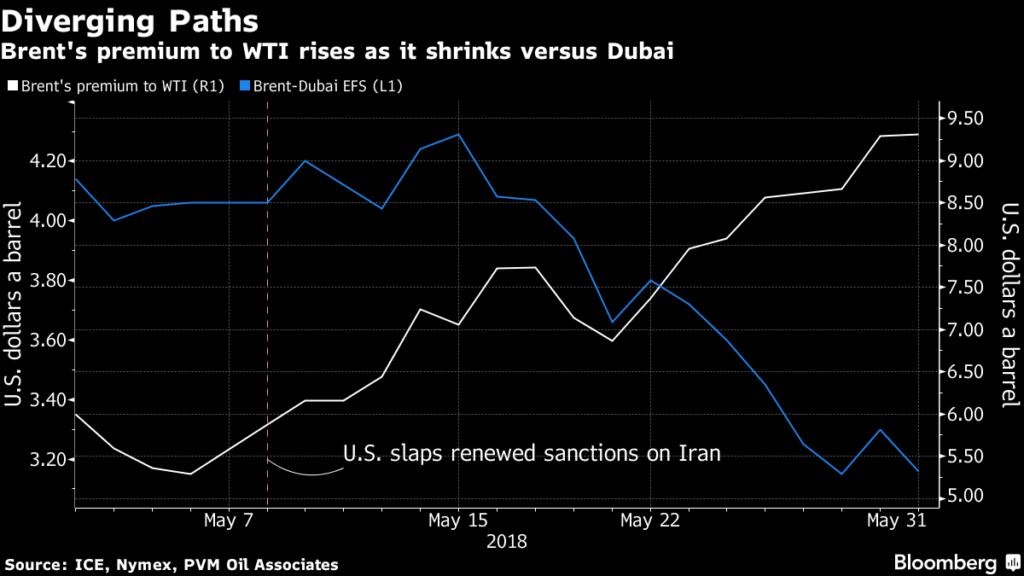
Long-established relationships between the world’s most important oil prices are being strained by conflicting forces across the globe.
Buyers grappling with crude’s rebound to levels last seen in 2014 are assessing how to take advantage of the differences between benchmarks, which determine the flow of crude around the world. Cheaper American varieties such as WTI Midland and Eagle Ford shale shipments are headed from the U.S. Gulf Coast all the way to Asia, the top consuming market, while some buyers are limiting Middle East cargoes that are seen as too expensive.
The discordance in prices signals how uncertainty over supply is playing out with varying impact on different corners of the oil market. A U.S. decision to renew sanctions on Iran risks curbing the OPEC member’s exports and is contributing to Middle East marker Dubai crude’s gain, while infrastructure hurdles in shale country are thwarting American benchmark West Texas Intermediate. In the meantime, a proposal by Russia and Saudi Arabia to revive output is weighing on Europe’s Brent.
Brent, the benchmark for more than half the world’s crude, is over $9 a barrel higher than U.S. WTI, the most in three years, data compiled by Bloomberg show. However, its premium to Dubai, indicated by exchange of futures for swaps, had shrunk to the least since January. And American oil is at its cheapest in at least two years to Middle East supply.
Prices within the U.S. are also diverging, with the cost of crude at the American Gulf Coast surging against WTI at Cushing, Oklahoma, in May.
“The three benchmarks — Brent, WTI and Dubai — have been fluctuating based on a combination of domestic factors, as well as wider geopolitical risks,” said Den Syahril, an analyst at industry consultant FGE in Singapore. “WTI is currently reflecting inland economics, as the U.S. struggles to bring oil to its coast. Brent and Dubai, on the other hand, are pricing in geopolitical tensions around U.S.-Iran sanctions, as well as uncertainties around the upcoming decision between OPEC and its allies.”
Cargo Rush
The effects are reverberating in the physical oil market. South Korean refiners such as SK Innovation Co. and GS Caltex Corp. have recently bought millions of barrels of everything from U.S. WTI to Eagle Ford and Bakken crudes. Indian Oil Corp., the nation’s top processor, is set to get WTI Midland as well as Light Louisiana Sweet cargoes in coming months. Japan’s JXTG Holdings Inc. is also receiving North American supply, as is Taiwan’s CPC Corp. and Thailand’s PTT Pcl and Thai Oil Pcl.
The trading unit of the biggest refiner in China, the top oil importer, is said to be shipping millions of barrels of U.S. crude to the Asian nation, with the flows tied to WTI’s favorable discount to Brent-linked grades. That was after the trader, known as Unipec, was said to cut contractual volumes from Saudi Arabia for a second month because it believes prices set by the Middle East nation are too costly.
Buying Boom
Apart from the risk to Iranian supply, other factors are also boosting Dubai crude. The total number of July-loading Middle East cargoes sold as part of an assessment process operated by S&P Global Platts to set price benchmarks has more than doubled to 14, or 7 million barrels, this month. That’s based on data compiled by Bloomberg from traders who monitor the market-on-close assessment process, usually referred to as the Platts window.
The surge in volume is helping keep Middle East crude in backwardation, a market structure where near-term cargoes are costlier than later shipments, signaling strong demand or tighter supply, according to three traders who participate in the market and analyst Nevyn Nah of industry consultant Energy Aspects Ltd.
Still, forward prices for Dubai crude show it getting relatively weaker versus Brent, according to Nah. That’s because international shipping-fuel regulations that take effect in 2020 are spurring speculation that consumption will boom for cleaner fuels, which are yielded more when Brent-linked oil is refined than from typical Middle East varieties.
Shale Bottlenecks
In the U.S., the shale surge is crashing into a barrage of bottlenecks. From West Texas pipelines to Oklahoma storage centers and Gulf Coast export terminals, the delivery system for American crude is straining to keep up with soaring production. While the nation is exporting supplies, the infrastructure problems are limiting the industry’s ability to take full advantage of growing worldwide demand.
That means prices of oil from the prolific Permian Basin shale play in Texas may fetch a discount of at least $20 a barrel to Brent over most of 2019, according to Raymond James Equity Research. Production growth from the region is likely to “massively” outpace local demand and there isn’t enough pipeline capacity to transport the crude elsewhere, it said in a note last week.
Recommended for you

